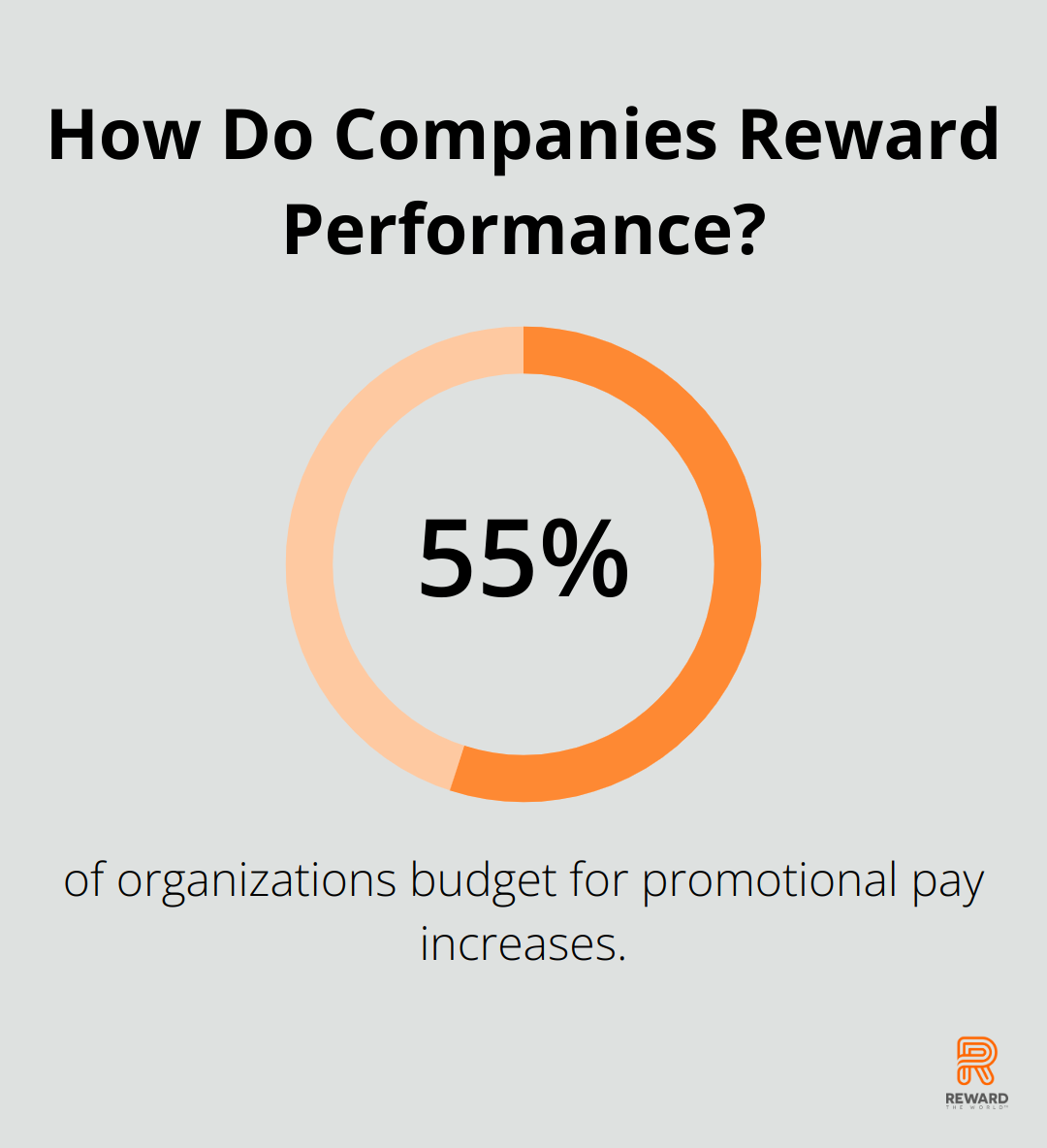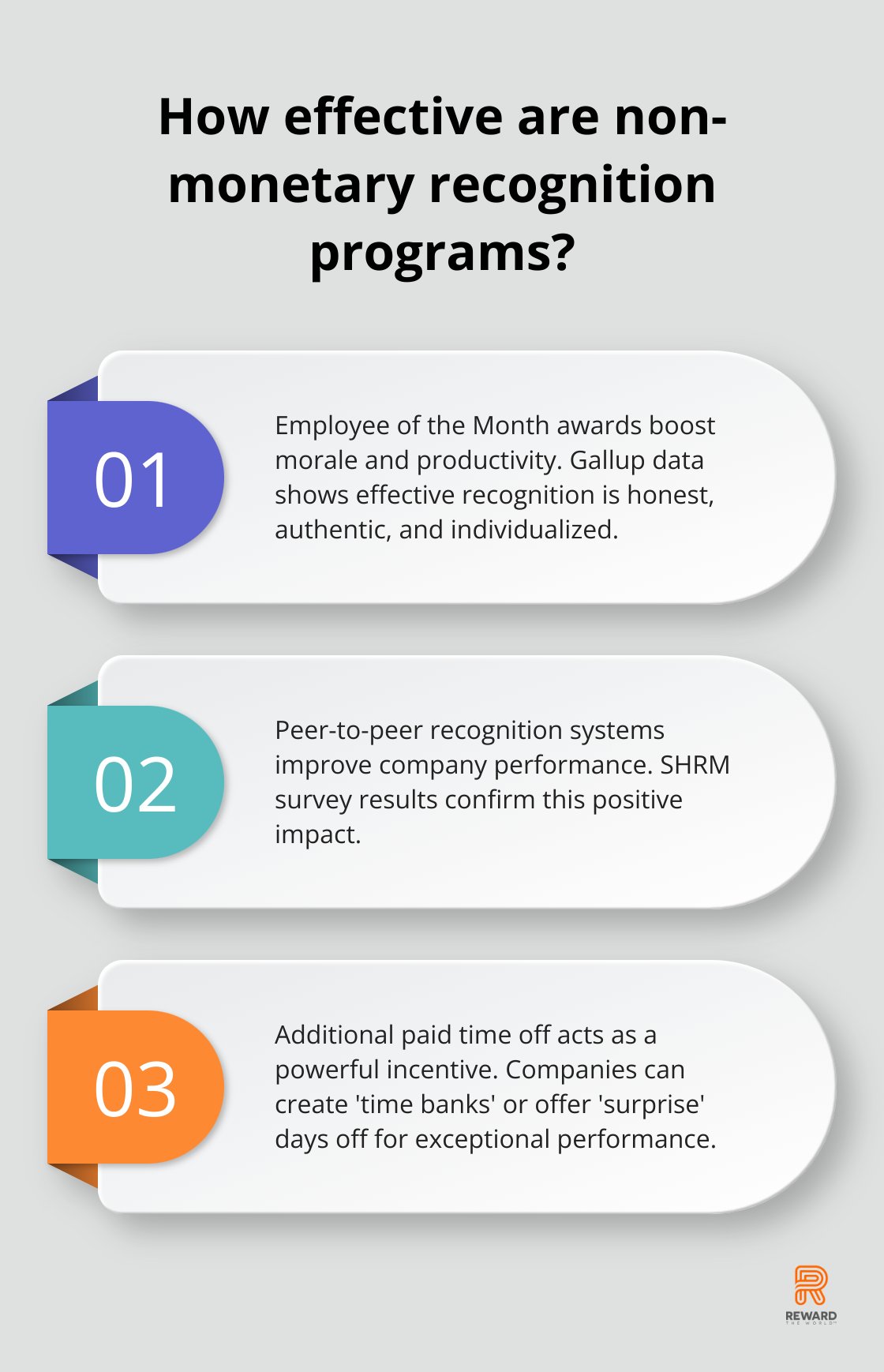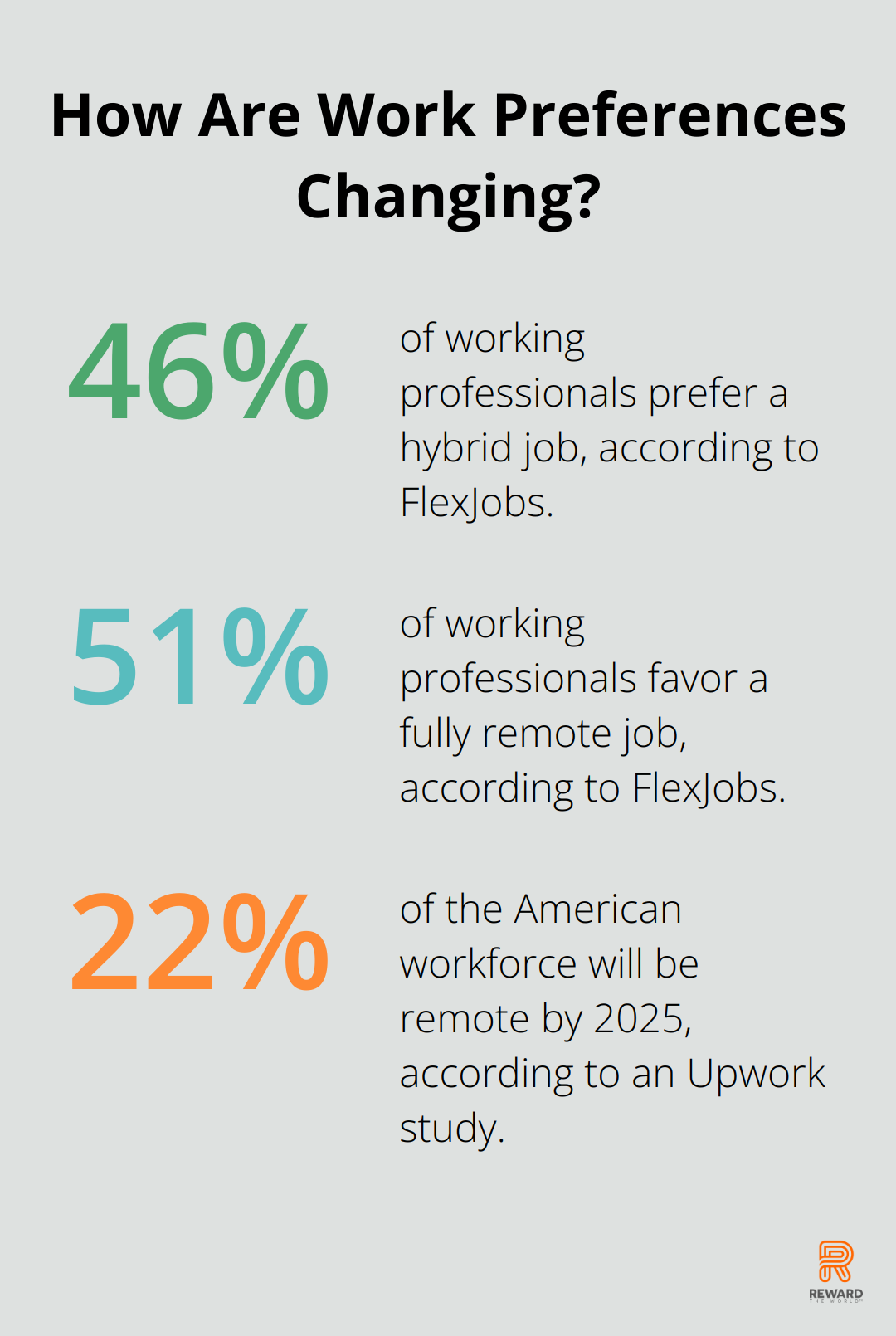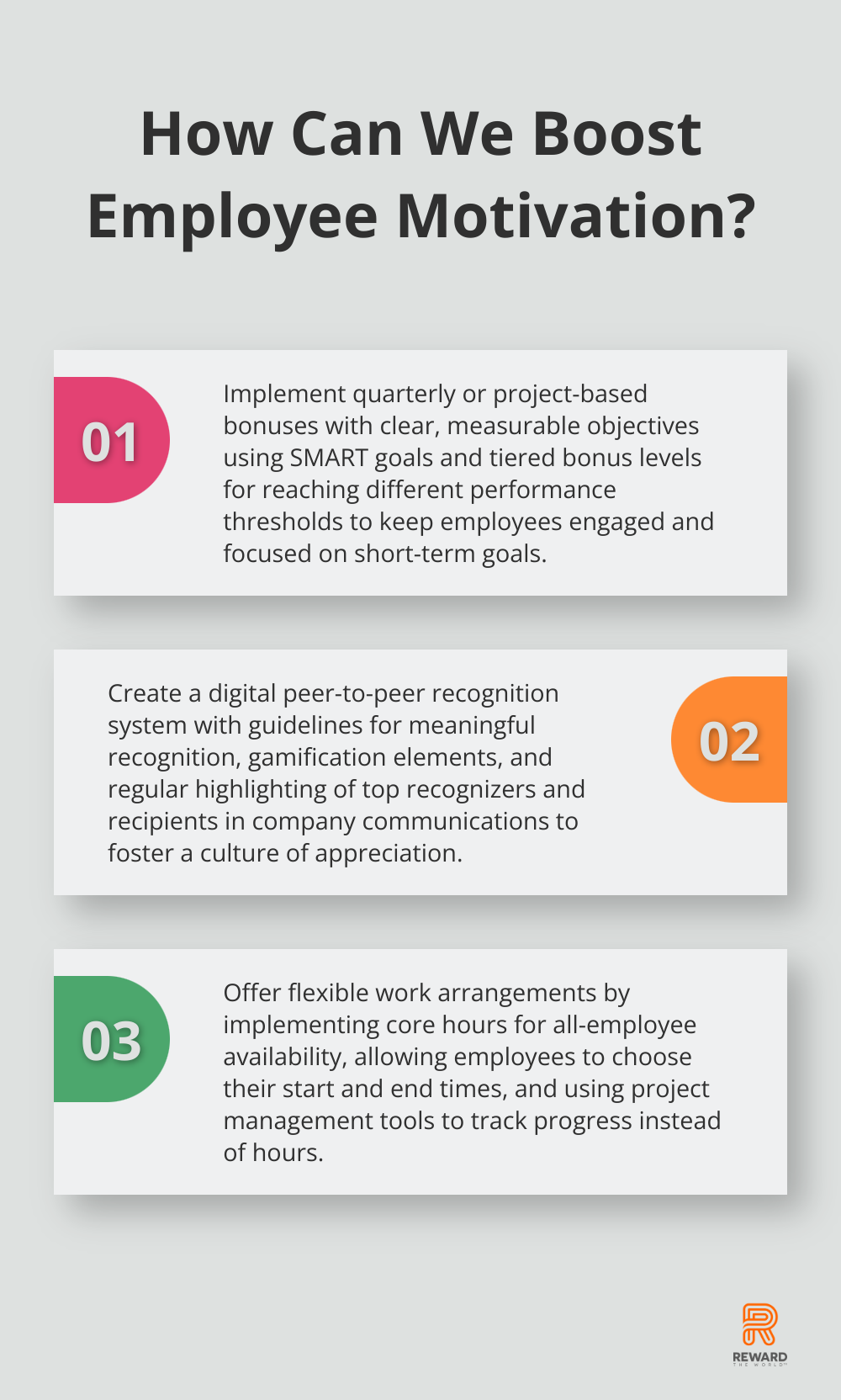
In today’s competitive job market, retaining top talent is a major challenge for businesses of all sizes. At Reward the World, we understand the power of short-term reward strategies to retain talent and boost employee satisfaction.
This blog post: Short-Term Reward Strategies to Retain Top Talent, explores effective methods to keep your best employees engaged and motivated, without breaking the bank. From performance-based incentives to flexible work arrangements, we’ll cover practical approaches that yield quick results.
How Performance-Based Incentives Boost Retention
Performance-based bonuses and incentives serve as powerful tools for retaining top talent. These strategies significantly impact employee satisfaction and motivation, leading to improved retention rates.
Quarterly and Project-Based Bonuses
Implementing quarterly or project-based bonuses keeps employees engaged and focused on short-term goals. WorldatWork’s research indicates that 55% of organizations budget for promotional pay increases. These bonuses provide immediate recognition for achievements, which reinforces positive behaviors and outcomes.

To implement this effectively:
- Set clear, measurable objectives at the beginning of each quarter or project.
- Use SMART goals (Specific, Measurable, Achievable, Relevant, Time-bound) to ensure clarity and fairness.
- Create tiered bonus levels for reaching different performance thresholds.
For example, a sales team might have a goal to increase quarterly revenue by 15%, with bonus tiers for reaching 10%, 15%, and 20% growth.
Profit-Sharing Programs
Profit-sharing programs align employee interests with company success. Research on employee ownership has explored its effects on firms and workers. These programs foster a sense of ownership and encourage employees to think like business owners.
To implement a profit-sharing program:
- Determine a percentage of profits to share (typically 5-20%).
- Establish clear criteria for distribution, considering factors like tenure, performance, and salary level.
- Communicate program details clearly to all employees, emphasizing how individual efforts contribute to overall company success.
Team-Based Performance Rewards
Team-based rewards promote collaboration and collective achievement. These rewards improve teamwork, innovation, and overall productivity.
Design team rewards around specific project milestones or departmental goals. For instance, if a development team launches a new product feature ahead of schedule and under budget, reward the entire team with a bonus or extra paid time off. This approach encourages knowledge sharing and mutual support among team members.
When implementing these strategies, tailor them to your company culture and employee preferences. Regular feedback and adjustments maintain their effectiveness. While financial incentives pack a punch, they should complement a broader retention strategy (including non-monetary recognition and career development opportunities).
As we explore the power of performance-based incentives, it’s important to consider other forms of recognition that can equally motivate and retain top talent. Let’s now turn our attention to non-monetary recognition programs and their impact on employee satisfaction and retention.
The Power of Non-Monetary Recognition
Non-monetary recognition programs serve as effective tools for retaining top talent. These programs tap into employees’ intrinsic motivations, fostering a sense of appreciation and belonging that extends beyond financial rewards.
Employee of the Month: Beyond a Simple Title
Employee of the Month awards, when implemented thoughtfully, can boost morale and productivity significantly. Gallup’s data reveal that the most effective recognition is honest, authentic and individualized to how each employee wants to be recognized. To make these awards impactful:
- Establish clear, objective criteria for selection
- Rotate the selection committee to ensure fairness
- Provide meaningful perks alongside the title (e.g., prime parking spot, lunch with the CEO)
- Celebrate winners publicly through company-wide announcements
Peer-to-Peer Recognition: Building a Culture of Appreciation
Peer-to-peer recognition systems empower employees to acknowledge each other’s contributions. SHRM survey results showed that companies that have implemented peer-to-peer recognition perform better. To implement an effective system:
- Use a digital platform for easy access and visibility
- Set guidelines for meaningful recognition (specific, timely, aligned with company values)
- Gamify the process with points or badges to encourage participation
- Highlight top recognizers and recipients regularly in company communications
Time Off as a Reward: Valuing Work-Life Balance
Offering additional paid time off as a reward acts as a powerful incentive in today’s work environment. To leverage this:
- Create a ‘time bank’ where employees earn extra hours off for exceptional performance
- Offer ‘surprise’ days off for completing major projects ahead of schedule
- Allow employees to ‘gift’ earned time off to colleagues in need

Consistency and authenticity play key roles when implementing these non-monetary recognition programs. Regular feedback from employees helps refine these initiatives to ensure they remain relevant and valued.
As we explore the impact of non-monetary recognition, it’s important to consider how flexible work arrangements can also serve as powerful rewards. Let’s examine how companies can use workplace flexibility to retain their top talent and boost employee satisfaction.
How Flexible Work Arrangements Boost Employee Retention
The Power of Remote Work Options
Remote work has become a game-changer for employee retention. Upwork Study finds 22% of American Workforce Will Be Remote by 2025. This shift goes beyond convenience; it’s about trust and productivity. Companies that offer remote work often see higher employee retention rates.

To implement effective remote work policies:
- Invest in robust communication tools for team connectivity
- Set clear expectations for availability and productivity
- Provide equipment or stipends for home office setups
- Schedule regular virtual team-building activities
Flexible Scheduling Enhances Work-Life Balance
Flexible scheduling allows employees to work during their most productive hours while managing personal commitments. FlexJobs found that 51% of working professionals favor a fully remote job, while 46% prefer a hybrid job.
To offer flexible scheduling:
- Implement core hours for all-employee availability
- Allow employees to choose their start and end times (within reason)
- Use project management tools to track progress instead of hours
- Train managers to lead and evaluate remote teams effectively
Compressed Workweeks: Maximizing Productivity
Compressed workweeks involve longer workdays but fewer days per week. This approach can increase job satisfaction and reduce burnout. Henley Business School found that 64% of employers reported increased productivity and improved work quality with a four-day workweek.
To implement compressed workweeks:
- Start a pilot program to test effectiveness
- Ensure coverage for customer service and critical operations
- Adjust workloads and deadlines to fit the new schedule
- Assess employee and business performance regularly
Tailoring Flexibility to Company Needs
When implementing flexible work arrangements, companies must adapt policies to their specific needs and culture. Regular feedback from employees and managers is essential to refine these programs over time.
Flexibility extends beyond location and timing; it creates an environment of trust and autonomy. Companies that offer these options demonstrate their commitment to employee well-being and work-life balance, which fosters loyalty and retaining top talent.
Final Thoughts
Short-term reward strategies to retain talent are essential tools for businesses to keep their best employees engaged and motivated. We explored various approaches, from performance-based incentives to non-monetary recognition programs and flexible work arrangements. Each strategy offers unique benefits, catering to different aspects of employee satisfaction and motivation.

The key to success lies in tailoring these rewards to individual preferences and continuously adapting them based on feedback. Regular check-ins, surveys, and performance reviews provide valuable insights into the impact of these programs. This process ensures that reward strategies evolve with changing employee needs and company goals.
At Reward the World (https://rewardtheworld.net), we offer a global incentives platform with a vast array of instant rewards available in multiple languages. Our solution helps companies create tailored incentive programs that resonate with their unique workforce. Investing in short-term reward strategies creates a positive work environment that attracts and retains top performers.
